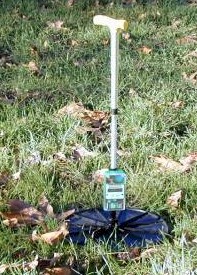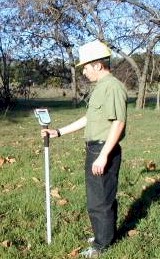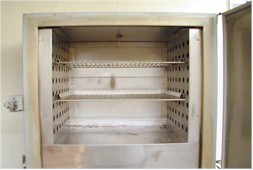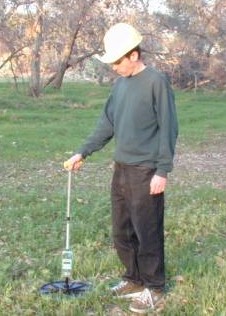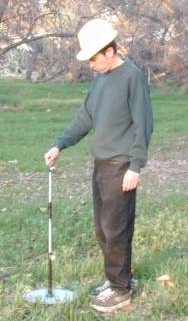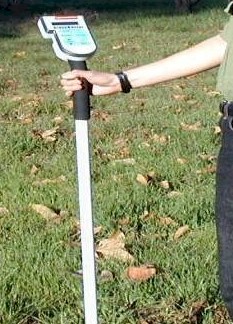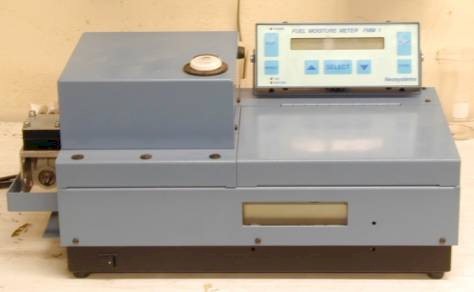|
BOB SIMONSON, Program Leader
HERBACEOUS MEASUREMENT DEVICE COMPARISON Lois Sicking, Mechanical Engineer |
||

San Dimas Technology
& Development Center
444 E Bonita Ave
San Dimas, CA 91773
(909) 599-1267
|
The
oven plates are designed with ridges and holes for the rapid removal of
moisture under compression. A high flow vacuum pump pulls moisture away
from the dish environment and water vapor is ejected through a plastic
tube on the side of the meter. The oven temperature is uniformly 284°F
(140 °C) across the plates, higher than the standard 220 °F (104
°C) oven. The manufacturer states that this increase in temperature
is offset by the substantially decreased bake time (1 h versus 21 h), oven
plate design, and use of a high flow vacuum pump.
After
a preset time period in the oven, the conveyor again places the dish back
onto the electronic balance to be weighed. The Neosystems II meter computer
subtracts the final weight from the initial weight and indicates the percentage
of moisture content on a liquid crystal display (LCD) screen. Using a separate
scale, the larger sample (total sample from a given area of the pasture)
is weighed and the weight is entered into the meter to determine the forage
in kg DM/ha or lb DM/acre. Other indicated values include the weight of
the carrier before and after baking, and the amount of kg DM/ha or lb DM/acre.
Various
forage types can be evaluated with this device by varying the bake time.
The standard Neosystems model allows for dual bake times. Bake times are
specified at the time of purchase, or an additional add-on option allows
the user to program specific bake times. The forage production value readout
is in lb DM/acre unless otherwise indicated at time of purchase. The Neosystems
II meter also determines moisture percent of various materials, including
leaves, plant material, soil, and any material with moisture percent up
to 1,000 percent.
|
|
Six
herbaceous measurement devices utilizing capacitance probe, rising plate,
and field portable oven meter technologies were field tested and compared
to the standard cut and weigh method (table 1).
Table
1—Herbaceous productivity measurement devices.
|
Blue
M Electric Oven—Typical Standard Mechanical Oven (figure 11).
|
Pilot
testing was conducted to determine the optimum forage sample collection,
the handling and processing method, and the test procedure. No publications
were found that describe detailed sampling collection, handling, and processing.
In addition, sampling methodology varies according to the specific plant
material.
Testing with capacitance probes and rising plate devices were conducted at one test site on a grid within the pasture boundary. There were 20 and 40 points sampled for each device at the same sample point. For use in the standard oven and Neosystems II meter testing, four sample points within the test site were chosen as representative points describing the average forage over the pasture plot. Twenty grid test points, including the four original sample points, were indicated by flagging. Consequently, all devices were tested on the same grid within the same sample points for the capacitance probes, rising plate, standard oven, and Neosystems II meter decreasing the variability of measurements. The forage contained within these four sample points was collected by the use of a frame of a known area of 1 cubic foot (2.4 liters.) All plant material was collected within the plot frame to bare soil (refer to: USDA Forest Service publication Rangeland, Analysis and Management Guide, August 1996 and the National Wildfire Coordinating Group–Forest Service publication “Measuring Moisture Content in Living Chaparral). Testing was conducted in Los Angeles County in California, elevation 1,100 ft in uniform grassland, June in the year 2000. Sample collection was conducted in the afternoon, with a temperature range of 80 to 90 °F. Samples were not collected in shaded areas or within 24 h of rainfall. Plastic gloves were worn to prevent moisture and oil from the hands contaminating the samples. All samples were cooled below the condensation temperature. Cooling was achieved by using a plastic lunch pail and an ice pack. Samples were stored in a refrigerator during processing. All samples were placed in zip-lock plastic bags, and double bagged with as much air removed as practical. Samples were handled with care to prevent moisture contamination during processing. Bag contents were examined and extra debris (e.g., dirt, rocks, and pellets) were removed. Plant material was cut into 1-in (25.4?mm) pieces, the minimum sample size, to ensure uniformity and the desired accuracy of 10 g for the standard oven and 7 g for the Neosystems II meter tests. The greater the variability of plant material, the smaller the pieces need to be cut. The larger the sample size, the greater the accuracy, but a larger sample size necessitated a longer the bake time. By cutting the samples into smaller pieces, accuracy was not affected. The sample was spread uniformly across the surface of the carrier dish. Before processing the test samples, the Neosystems II nylon oven carrier was preheated in the oven meter for 20 min to remove moisture typically absorbed by nylon at room temperature. The carrier must be preheated to ensure accuracy. Large errors will result if preheating is not done. All the test samples were placed inside the pan or carrier with no plant material hanging over the edges. All equipment was calibrated daily. Bake times for this test were 16 and 20 min. This consisted of a 4 min bake with 3 repeat cycles for a total time of 16 min and a 10 min bake with 1 repeat for a total of 20 min. The method used to determine an accurate productivity measurement to represent a pasture plot was with 4 representative samples. Each sample was tested 3 times for a total of 12 tests at 20 min each. The total test time used in this project was 4 h. Further analysis indicates that at this test site, this accuracy can be achieved with 3 representative samples, each sample was tested 3 times, for a total test time of 3 h using only 1 Neosystems II meter. However, the total test time is reduced to 1 h using 3 Neosystems II meters, as compared to 21 h for the standard oven. A
mechanical convection oven was used in the standard oven method at 220
°F (104°C) with a bake time of 21 h. The aluminum pans were weighed
cold and hot. These weights were used appropriately in the calculation
of initial and final weights.
The rising plate and capacitance probe devices are indirect type measurement devices; therefore these devices require a change of the forage constant in the productivity equation to allow for different pasture types and seasonal variations. The standard oven and Neosystems II meter do not require this change in forage constant because these devices take a direct measurement of the plant material. The development of a forage constant for indirect measurement devices requires a productivity measurement by a direct device, (i.e., by the standard oven or Neosystems Oven Meter in order to determine a new forage constant). The GrassMaster Pasture Meter Company has developed a software program using statistical analysis to develop this forage constant. The input values necessary to develop a new constant are obtained by supplying a direct measurement of productivity measurement obtained by use of the standard oven or Neosystems unit. The GrassMaster provides the optimum method to determine the appropriate forage constant. The Effect of Minimal Stubble Height Grazing practices, based on established agronomic principles, indicate that stocking rates on grazed forages be managed to allow for a minimum stubble height of 2 to 3 in (50.8 to 76.2 mm) in order to maintain a productive pasture. This minimum stubble ensures that the plant has enough energy reserves after grazing to support regrowth, allowing roots to become stronger and deeper, providing for a pasture with adequate forage, resistance to insect and disease damage, and drought and weed resistance. Erosion control and water quality are also improved. Stubble also includes residue and litter mass. Sampling protocol for obtaining productivity measurements with the standard oven and Neosystems II meter is to collect the total residual biomass to bare mineral soil. This total residual biomass is weighed and used in the forage productivity calculation. In contrast, rising plate and capacitance probes are not able to measure total residual biomass by design. The shaft of the rising plate has a 1.25?in- (31.75-mm-) diameter metal washer on the end, preventing the tip from penetrating the residual biomass. Capacitance probe shafts are 1 in- (25.4 mm-) diameter with a 0.25-in (6.4?mm) metal prong tip at the end. The tip is designed to prevent the shaft from direct contact with the ground. However, the residual biomass mat is thicker, typically 2 to 3 in (50.8 to 76.2 mm) in some pasture plots. The 1?in- (25.4-mm-) diameter shaft prevents the probe from penetrating the biomass mat beyond the 0.25-in (6.4-mm) tip for a complete measurement of the residual biomass. Consequently,
the rising plate and capacitance probe device measured values were expected
to vary from the measured values for the standard oven method and the Neosystems
II meter.
Seven
herbaceous measurement devices were used to collect data from the same
pasture plot. The standard error and correlation between all devices and
the standard oven were determined. The findings are indicated in tables
2 and 3. There is significant variability between the direct and indirect
type measurement devices. This is anticipated due to a need to change the
forage constant for all indirect devices and the effect of collecting on
bare soil rather than minimum stubble height, as is the current practice
in the direct measurement devices.
|
|
||||||||||||||||||||||||||||||||||||||||||||||||||||||||
|
Standard
error—Standard error is a measure of variability or dispersion of data
compared to the standard oven method. The least variability is indicted
in the Neosystems II meter at less than 1 percent, with all other devices
indicating a high standard error.
Correlation
coefficient—The correlation coefficient (r) is a measure of
the degree that the measured data from two devices move together or in
opposition. When r = 0, there is no correlation. When r =
1.0, there is perfect correlation. The higher the r, the greater
the correlation. General practice indicates that r values be generally
evaluated as follows:
r
= 0.00 to 0.25 = doubtful correlation
r = 0.26 to 0.50 = fair correlation
r = 0.51 to 0.75 = good correlation r = 0.76 to 1.00 = superior correlation The Neosystems II unit had a 0.94 correlation with the standard oven. This degree of positive correlation is considered superior. The GrassMaster had a 0.74 correlation and the Filip Folding Plate Pasture Meter had a 0.58 correlation, all considered good. However, forage constants for the GrassMaster and Filip Folding Plate Pasture Meter devices need to be developed for specific pasture plots and the issue of minimum stubble height needs to be addressed before these devices are used in the field for any application requiring less accuracy than currently provided by the standard oven or Neosystems II meter. Precision
denotes degree of repeatability in taking of the measurement. The range
of percent differences is an indicator of precision. The data reduction
results are presented in table 3.
|
Percent inaccuracy—Percent inaccuracy is the specification that could be met at the 95 percent confidence level. Assumptions are made that the data here was not a 1-in-20 or rarer anomaly and that the test measurements follow a normal distribution with the mean equal to the standard measurement. Accuracy denotes the absolute nearness to the true value. The smallest inaccuracy determined was with the Neosystems II meter at 2.6 percent; with the Pasture Gauge at 61 percent less than the oven measured value. All other devices had less accuracy. Accuracy can be improved, up to a point, with some devices by the collection of more samples. Testing was conducted using sample sizes of 10, 20, 30, and 40, with each of two operators. These values were compared to the standard oven method. The greatest increase in accuracy with increased sampling was realized with rising plate technology by increasing the sample size to 40. Percent bias—Percent bias indicates if the device is consistently over or under measures values. Bias can be used as a correction factor for measured values to obtain the true value. This correction factor is specific for each device and may vary across the range of measured values. The smallest bias standard is met by the Neosystems II meter at 0.4 percent, followed by the Pasture Guage, the Farm Tracker, the Filip Folding Plate Pasture Meter, and the GrassMaster. Percent difference—Percent differences were calculated between measured values for the standard oven and the test device. The smaller the range of percent differences the better. The smallest range of percent differences is met by Neosystems II meter, followed by GrassMaster, Farm Tracker, and Filip Folding Plate Pasture Meter. Variability—There is significant variability between all sliding plate and capacitance probe devices as compared to the standard oven method. However there was minor variability between measured values for the Neosystems II unit and the standard oven. Sources of variation contributing to these variable results include differences among operators, ambient atmospheric conditions, test procedures, test instruments, and differences over time. Pilot testing, conducted prior to testing, determines the best test method with decreased variability and increased repeatability. A detailed test plan was developed from pilot testing with concise specific instructions for each device, including standard test conditions, test procedures, and test conditions. Testing of all devices was conducted over a minimum time period to reduce the variability over time. Variability
was expected between the direct and indirect measurement devices. The Neosystems
II and standard oven methods take a direct measurement. A direct measurement
can be expected to have improved accuracy over an indirect method, such
as capacitance probe and rising plate technology (see previous section).
Findings of this study support this with the best accuracy and lowest standard
error from Neosystems II, followed by capacitance probe and rising plate
technologies.
Comparison Between Neosystems II Meter and Standard Oven The Neosystems II portable oven has the highest degree of correlation, accuracy, and consistency of all devices when compared to the standard oven. The time to obtain a productivity measurement representing a pasture plot with best accuracy is with 3 representative samples for the lot, each sample was tested 3 times at 20 min each. It takes 1 h to determine productivity measurements if 3 Neosystems II meters are used or 3 h if 1 Neosystems II meter is used. This is an improvement over 20 to 24 h for the standard oven. The Neosystems II does not require the determination of the forage constant. In addition, this device is designed for use in various types of forage involved in inventory and monitoring activities. Consequently, it is recommended that consideration be given to designating the Neosystems II meter as the standard for obtaining production and utilization measurements. Comments were solicited from the operators participating in pilot and field testing. Their comments are recorded in table 4. Table 4—Summary of the comments concerning the different devices tested.
Discussion The Neosystems II meter temperature is set at 284 °F (140°C) across the plates. The temperature for the standard oven was set at 220 °F (104°C), 64 °F (18 °C) lower than the Neosystems II meter. This increase in oven temperature alone would typically increase the release of volatile oils from the plant material and adversely affect the accuracy of the measurement. The manufacturer of the Neosystems II meter states that this was taken into consideration in the design. A fine balance was developed between an increase in oven temperature, offset by a substantial decrease in time to bake (1 h versus 21 h), oven plate designed with ridges and holes for the rapid removal of moisture, vacuum pump, and oven plates compression. All focused on significantly decreasing bake time, without increasing the release of volatile oils from the plant material. Differences in readings between operators are due to technique, such as using a greater force in positioning the rising plate meter or capacitance probe onto the ground. Also, all readings must start in open air and the device must be brought straight down (vertically). The capacitance probe shaft picks up debris and must be cleaned frequently. This must be recognized and performed by the operator. Capacitance probe meters were having difficulty picking up readings in the plant material with low fuel moisture content, such as dry, cured grasses. Occasionally, the capacitance probe would indicate a reading and display a value of “500 kg DM/ha,” in dry, not cured grass. This was determined to be a minimum reading for the given unit and did not reflect an accurate measurement. Capacitance probe measured values are directly proportional to plant moisture content. It is important that the operation of the device be understood and followed to obtain accurate measurements. The findings are as follows: 1. The Neosystems II portable oven has the highest degree of correlation, accuracy, and consistency compared to the standard oven. Use of the Neosystems II requires more labor than the sliding plate or capacitance probe meters. 2. The Neosystems II meter has 94 percent superior correlation with the standard oven. The GrassMaster capacitance probe has a 74 percent correlation followed by the Jenquip Sliding Plate with 58 percent. The Kencove sliding plate and Alistair capacitance probe have fair correlation, and the Draminski has doubtful correlation with the standard oven method. 3. The type of device appropriate for use in a particular application will depend on the required accuracy for that application. 4. Rising Plate devices have a low correlation and accuracy when compared to the standard oven method. Capacitance probe correlation and accuracy varied. 5. The most accurate capacitance probe was the GrassMaster Capacitance Probe. The GrassMaster had a 74 percent correlation with the standard oven method and accuracy much lower than the Neosytems II or standard oven method. Forage constants must be developed for specific pasture plots and the issue of minimum stubble height needs to be addressed before field use of the GrassMaster capacitance probe for any application requiring less accuracy than currently provided by the standard oven or Neosystems II Meter. 6. The most accurate sliding plate was the Jenquip Sliding Plate. The Jenquip had a 58 percent correlation with the standard oven method and accuracy lower than the Neosytems II or standard oven method. 7. Consideration should be given to the Neosystems II meter as the standard for obtaining production and utilization measurements when replacing the oven method. 8.
There is a need for a field users guide for sampling, collection, and processing
forage production samples for use with the standard oven and/or Neosystems
II oven meter. This evaluation should consider minimum stubble height.
Based on the findings of this study, the following is recommended: 1. Use the Neosystems II meter to obtain accurate forage production measurements in the determination of stocking rates and the effectiveness of certain land treatments such as burning, herbicide applications, and fertilization. 2. A field users guide for sampling, collection, and processing be developed regarding forage production samples for use with the standard oven or Neosystems II meter. This guide should address sampling considerations regarding minimum stubble height. 3.
Forage constants need to be developed for specific pasture plots and the
issue of minimum stubble height needs to be addressed, for the GrassMaster
capacitance probe or Filip Folding Plate Pasture Meter, before field use
for an application requiring less accuracy than currently provided by the
standard oven or Neosystems II meter.
Draminski Inc. Pasture Meter PL-10-860
Olsztyn
Tru-Test Limited GrassMaster 11915 Starcrest Drive San
Antonio, TX 78247
Tel: 1–800–874–8494, 210–495–9130; Fax: 210–495–9129 e-mail:fences@trutest.co.nz ; web site:www.trutest.co.nz Jenquip Filips
Folding Plate Pasture Meter
Kencove Farm Fence Inc. Farm
Tracker Rising Plate Meter
Alistair George Manufacturing Pasture
Gauge
Sigma Delta Technologies Pty Ltd. Fuel
and Soil Moisture Model Neosystems II
|
||||||||||||||||||||||||||||||||||||||||||||||||||||||||||||||||||||||||||||||||
Neosystems II Meter—Model Fmm-1
Short Instructions
Please see the operator’s manual for specific detailed instructions.
Warnings
- DO NOT remove power from the meter until a run is completed or it is in the main menu.
- Ensure the RED lead is connected to the POSITIVE of the battery and the BLACK lead to the NEGATIVE.
- DO NOT move the meter unless the balance is locked. This is indicated by no display on the balance LCD. If there is a display showing, then reset the meter (press STOP) again until the display shows nothing. If this fails to occur after a number of tries, then remove the nylon base plate under the meter and screw the lock pulley clockwise until the lock is in place (i.e., it is fully up). DO NOT over tighten or else it will not be able to be unlocked by the lock motor. DO NOT ship the meter with the balance pan in position, remove it and put aside.
- DO put the meter on a level surface free of any vibration. Keep the meter clean and free of dirt.
1.Turn off the meter by use of the switch at rear of the unit.
2.Connect the red lead to the positive of the battery and the black lead to the negative.
3.Turn on and wait for approximately 10 seconds for the meter to initialize. When complete, the message “NORMAL OP'NS” will be displayed.
4.This is the start of the main menu. If you wish to have normal operations, press the “SELECT” button. The message "WAITING FOR TEMP" will be displayed until the set temperature of the bottom and top heating plates is reached.
5. Then the message “READY” will be displayed. Place the sample in the carrier holder and put in on the balance pan within the balance ring. Close the lid and press “START” to initiate a measurement.
6.The sample will be moved to the left and the balance will be tared. The sample will be placed over the balance and the wet sample weight taken.
7.The sample then moves to the left, over the bottom hot plate. This plate is then raised until the sample is firmly compressed between the two plates and the lift motor will be turned off. When the lift motor starts to operate, the vacuum pump will be turned on. This is to start heating up the vacuum pump.
8.After approximately 3 1/2 min, the bottom plate will be lowered to put the sample level with the balance. The vacuum pump will be turned off and the balance will be tared. The sample will be conveyed to the balance, weighed, the moisture percentage calculated, and the result displayed.
9.The operator is then given the choice of repeating the run, by pressing the “REPEAT” button. A repeat is necessary in the event of very wet samples.
10.If a new sample is to be run, press the “START” button. This process can be continued indefinitely.
11.After a reading is displayed, there is the option to store the result by pressing the “STORE” button. The memory can store 253 results. To return to the main menu, press the “STOP” button.
See the full manual for specific detailed features and other functions.
Sampling and Obtaining Consistent Results
At each point of the sampling (collection, measuring, and putting into the carrier) there is a potential source of errors. These errors may even be cumulative so care should be taken at each step.
1.Make sure that when collecting samples you collect enough to be representative of what you are trying to measure. Do not let anything contaminate the samples. To avoid this, wear gloves when collecting samples and do not let any moisture come into contact with the samples at any time. If not measuring the samples right away then bag each sample and ensure an airtight container is used. Keep the samples cool if they are not to be measured right away.
2.When preparing the sample, ensure that the full sample is homogeneous and uniform throughout. For instance, Chemise is very uniform and pieces as large as 1 to 2 in (25.4 to 50.8 mm) can be used. In the case of grasses, there can be great variability so care must be taken to cut the sample into small portions so that the sample to be measured is representative of what was collected. If you do not follow these steps, then you will find wide variations in the readings measured. This is particularly evident in high moisture samples.
3.Once having prepared the samples in step 2, mix the sample thoroughly using gloved hands. Next select a “bunch” from the sample and place it in the outer carrier holder. You should try and get a minimum of 7 g in the carrier. DO NOT select one leaf, blade, etc at a time. “Grab a handful” so that the sample is more representative. Spread the sample out evenly in the carrier and place the inner the carrier on top of it. Press down to ensure that the inner carrier does not protrude above the outer carrier. If this happens it may interfere with the weighing mechanism and lead to false results. Also, ensure that no sample protrudes above the outer carrier.
4.Place the carrier and sample on the balance pan by first making sure that the pan is clean and centrally placed. Close the lid and press “START.” Allow the meter to measure the moisture percentage.
5.The outer carrier is made from nylon, which is hygroscopic and thus will vary in weight. The carrier needs to be dried out completely or alternatively the weight should be continuously entered into the meter (see CALIBRATE function). Calibrate the Neosystems meter only after preheating the oven carrier. Using old values of calibration can lead to significant errors. The time to drive off all the moisture in the nylon carrier will vary. However, 24 h in an oven at 221 °F (105 °C) should accomplish this. On existing meters a 10-min bake with the nylon carrier empty, carried out for a number of cycles would suffice. Further checks need to be done to determine the optimum preheat times of the nylon carrier.
6.The larger the sample size and the larger the sample pieces, the longer it takes to remove all the water; and the smaller the size, then less representative it is. If the sample is cut into small pieces, the drying time will be quicker and you will also be able to use more samples and be more representative. Sigma Delta suggests that you experiment to see what is optimal at each area of moisture percent. Each species will be different. Trial and error will show the size versus time considerations.
Data output
Data may be downloaded from the oven meter to the PC. This is achieved with Hyperterminal. In Windows 95, Hyperterminal is located in the accessories folder and in Millennium Edition it is located in accessories/communications.
The Hyperterminal program can be used to capture the data coming from the Neosystems II meter in ASCII, comma delimited data. From there the file can be imported into a spreadsheet program or data acquisition program, such as Labview.
Incorrect results—Results of 0.0 percent can arise if no sample is put in the sample holder and “START” is pressed.
Readings too low—This will occur if you have not prepared the sample. It could also occur if the sample moisture is very high. This may mean that a repeat reading is necessary. It could also result from some species where bound water is such that a longer time is necessary in the oven. Repeat samples will get over most of these problems. Another solution where the sample is uniform is to reduce sample size. Reducing sample size when the sample is not uniform will lead to variable results.
Readings too high—This could be due to incorrect balance readings or oils being driven off. High readings can be due to the inner carrier or sample protruding above the level of the outer carrier. The high readings may also show on the display as D12.5% for instance where the alphabetical character may be A, B, C, D, E, or F. This says that the readings are above 1,000 percent, which should never occur. This indicates that the initial wet weight is higher than it should be and is caused by an incorrect balance reading. If you encounter this continuously, leave the lid open so you can observe any interference to the weighing operation.
Error on results—This will be due to the dry weight being more than the wet weight, something that should never occur. The cause of this could be incorrect balance readings due to the sample holder not being free of the balance ring.



